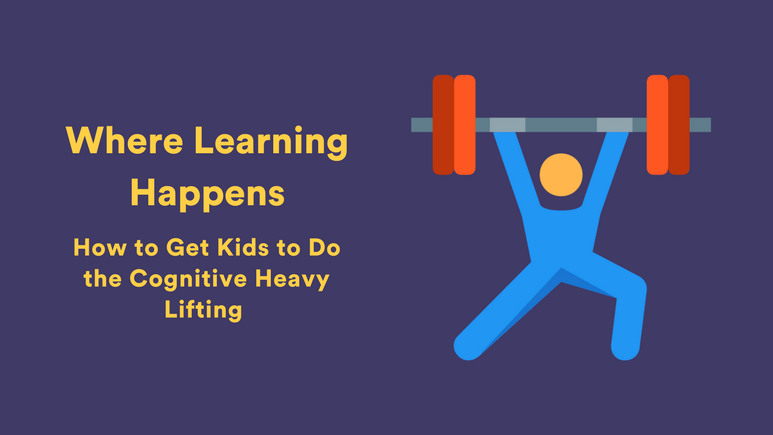
Imagine trying to build muscles by going to the gym every day.
But instead of lifting weights, you merely watch your personal trainer lift.
Needless to say, this wouldn’t get you very far in your quest for strength.
We often equate the brain to other muscles in our bodies in that the more use it gets, the stronger it will become.
In school, we want students to use their brains in new and challenging ways in order to get stronger. We want students to do the cognitive heavy lifting required to solve problems and analyze texts.
Sometimes, though, teachers end up doing much of the cognitive lifting themselves without even realizing it.
Giving hints, letting only one student answer, and providing too many examples can all decrease the rigor of tasks and prevent students from actually engaging their brains in challenging cognitive work.
Below we share some tips to encourage teachers to step back and let students struggle with a challenging task on their own for the sake of letting their brains do the work.
Maximize Wait Time
If every time you posed a question to the class you called on the first hand that went up, then for each question only one student would successfully reach the answer independently.
It’s a fact of the profession (and human nature) that different students will arrive at answers at different paces.
Be thoughtful about accommodating these different paces in your room.
When you ask the whole class a question, try waiting until you’ve got at least 80% of hands up before calling on a student. Or, find other ways to have students demonstrate understanding, such as writing out answers, sharing with a partner, or using whiteboards.
Learn more about the impact of wait time here.
Use Prompts vs. Cues
What do you do when a student gets a question wrong? This can be one of the trickiest parts of teaching.
In general, it’s good practice to give the student some sort of a prompt or clarification to help him get closer to the answer. Sometimes, though, teachers go too far in revealing the correct answer to students – giving a cue.
As a rule of thumb, prompts might rephrase the original question or point students in a certain direction, while cues reveal exactly what part of their answer is wrong and why – thus removing much of the cognitive rigor.
Keep Quiet
As teachers, we have a tendency to talk. Sometimes A LOT.
I’ve been in countless classrooms where a teacher will set students off to work on a challenging question and then immediately begin narrating the first step.
In order for students to do the most cognitive lifting possible, you need to remove yourself from the problem solving initially.
Try setting a timer for the first five minutes or so of work time during which you won’t answer any questions. Let students use each other, their notes, examples, and whatever else they can thing of to construct meaning. You’d be surprised how much students can do on their own if you let them.
Re-Frame the Problem
James Nottingham, an educator in Australia, crafted the idea of “The Learning Pit”.
In this practice, a teacher poses a challenging question to students and creates an expectation that they’re going to enter a “pit” where there won’t be clear answers. Only teamwork, problem-solving, discussion, and careful research will get them out of the pit.
Teachers around the globe have seen this mere re-framing boost student investment and creativity when it comes to solving challenging problems.
Create Intentional Teams
Letting students work together is a great way to let them do the cognitive lifting while still providing them with a support system.
Be thoughtful about how many students you want per group, and who should work together.
In general, the fewer students per group, the more cognitive responsibility each student will have.
You can also vary the amount of scaffolding students get by challenging some kids to work on their own or with one partner, while others work in larger teams.
Make Material Relevant
If you really want students to dig into a tough question and give it their all, it helps if it’s something they care about.
Worried that Greek History or scientific method aren’t going to spark their interest? Find ways to connect elusive academic concepts to students’ lives or something else you’ve learned.
Share Greek inventions we still use today. Or have students use the scientific method to create slime.
Focus on the “You Do”
Traditional pedagogy often includes a gradual release of control to students.
Teachers model a skill (“I do”), the class practices together (“We do”), and finally students take a stab at it on their own (“You do”).
Unfortunately, by the time the bell rings, it isn’t uncommon for the teacher to have done most of the thinking with this setup. Make sure that “I do” and “We do” cycles are short enough for students to spend most of the class doing the work themselves.
You can even flip this sequence on its head and see if pairs of students can tackle solving a new problem without any direct instruction. Talk about cognitive heavy lifting!
Some of these tips might go against your instincts, but by fighting your urge to jump in, students will take more cognitive responsibility for a task.
Give it time, and their brains are sure to grow!



Leave a Reply